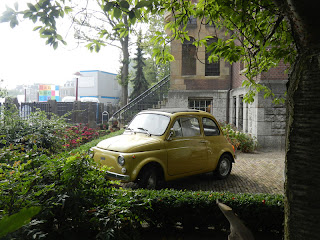One of my travel apps had a nice walking tour of Montmartre, so we decided to explore it via this tour. The day was beautiful with nary a cloud in the sky and a balmy 92 degrees. I definitely earned my morning pain au chocolat that day as one of the things I did know about Montmartre was that it is very hilly. Walking up steep heels in 92 degrees isn't exactly my idea of fun, but I'm not going to complain. I was in Paris on a glorious, sunny day. What's not to love about that?
In the picture above, this is one of only two remaining iron and glass Art Nouveau canopies designed by famed architect Hector Guimard in 1900. Montmartre is primarily known for the white-domed Basilica of the Sacré Cœur on its summit and as a nightclub district.
Since Montmartre was outside the city limits, free of Paris taxes and no doubt also due to the fact that the local nuns made wine, the hill quickly became a popular drinking area. The area developed into a center of free-wheeling and decadent entertainment at the end of the 19th and the beginning of the 20th centuries. In the popular cabaret the Moulin Rouge, and at Le Chat Noir, artists, singers and performers regularly appeared. By the end of the 19th century, Montmartre become the principal artistic center of Paris. A restaurant opened near the old windmill near the top, the Moulin de la Galette.
Many artists, including Vincent van Gogh, Henri Matisse, Pierre-Auguste Renoir, Edgar Degas, and Henri de Toulouse-Lautrec, worked in Montmartre and drew some of their inspiration from the area.
The view from the top of this hill was pretty spectacular.
Next up was the most charming street, with peek-a-boo views of Sacré Cœur and charming ivy-covered homes.
At the top of this hill, was a lovely reprieve from the heat. And yes, we did indulge ourselves with some delicious rosé!
Paris' only working vineyard, Clos de Montmartre is right around the corner from La Maison Rose. Long before Lutèce became Paris, the Montmartre area was planted with grapevines. The Romans had built a temple there dedicated to Bacchus, the god of wine. A Benedictine abbey was founded on the hill in the 12th Century which included a wine-press operated by the nuns. Although the abbey was destroyed during the French revolution, the vineyards stayed in operation. The Montmartre district became home to church-owned vineyards that produced wines for the local cabarets and drinking establishments.
During the 18th and 19th Centuries, wines from other areas began to increase in popularity: outbreaks of disease and the increasing urbanization of Paris meant that gradually the vineyards in and around Paris all but disappeared. Fortunately in the early ‘30s a group of local artists asked the government to grant them a patch of land between rue des Saules and rue St-Vincent to recreate the Montmartre vineyards. The government approved the plan, and Clos Montmartre was renewed in 1933, with the first harvest as early as 1934. Because the artists’ knowledge of wine growing was quite limited, they organized the first grape harvest the year immediately after planting, unaware that grapes need four years before they can be pressed for wine.
The grape-picking ceremony has been repeated every October since, except during World War II. Owned by the Mairie de Paris, the Clos Montmartre - the last active vineyard inside the Paris city limits covers 1,556 square meters and contains 1,900 vines of 28 different grape varieties including Gamay and Pinot Noir.
Fortified after our wine and beer stop, we had one last LONG hill to climb taking us up to the top of the hill to Sacré Cœur.
I swear they sell every tourist tchotchke along the streets of Montmarte. Boxers with Eiffel Tower? Check. T-shirt with "Paris" bedazzled all over it? Check. Poorly executed "painted" canvas of every single Paris monument? Check check. My disdain for this obvious attempt to capture every tourist dollar is why I visited this area on my very first visit to Paris and haven't been back since.
The Church of St. Pierre, is one of the oldest in Paris and even contains some original Roman columns.
I do love the architecture of Sacré Cœur. The Basilica of the Sacred Heart of Paris, commonly known as Sacré-Cœur Basilica is a Roman Catholic church and minor basilica, dedicated to the Sacred Heart of Jesus. Construction began in 1875 and was finished in 1914.
\
The views of Paris from the front of the church are amazing.
Our stomachs were now begging for lunch as it was almost 2:00 PM, so we decided to wandered a bit outside the district to find a nice bistro for lunch, well away from the throngs of tourists looking to purchase thongs with "Paris" bedazzled on the front.
You can view my pictures taken during our walking tour of Montmartre here.
A bientôt!




































































